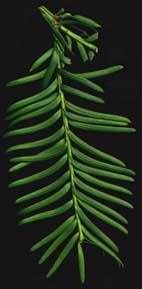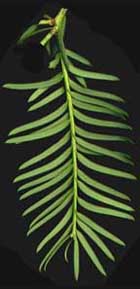
Upper surface of a first-year shoot [C.J. Earle].
Common Names
Pacific or western yew, mountain mahogany (2).Taxonomic notes
Syn: Taxus baccata Linnaeus subsp. brevifolia (Nuttall) Pilger; T. baccata var. brevifolia (Nuttall) Koehne; T. baccata var. canadensis Bentham; T. bourcieri Carrière; T. lindleyana A. Murray bis. The name T. baccata Hooker has been misapplied to this species (1).Description
Dioecious shrubs or small trees to 15(-25) m tall and 50(-140) cm dbh. Bole straight to contorted, fluted; crown open-conical. Bark scaly, outer scales purplish to purplish brown, inner ones reddish to reddish purple, scales varying widely in size (2-50 mm wide). Branches ascendent to drooping. First-year shoots green, entirely covered by decurrent leaf bases; older twigs red-brown, resembling bark by the third year. Foliage buds inconspicuous, arising terminally or at the adaxial base of a leaf. Leaves green, linear, acute, mucronate, 8-35 mm long, 1-3 mm wide, pliable, often falcate, with a narrow median ridge on the upper surface and stomata in two yellow-green (not glaucous) bands of 5-8 lines on the lower surface, whorled but appearing 2-ranked, with a short (c. 1 mm) petiole and a 5-8 mm long decurrent leaf base; cuticular papillae are present along stomatal bands and epidermal cells as viewed in cross section of leaf are mostly taller than wide. Pollen cones solitary or clustered, adaxial on year-old shoots, buds globose, green, ca. 1.5 mm diameter. Seed ovoid, 2-4-angled, 5-6.5 mm, maturing late summer-fall, enclosed in a red aril ca. 10 mm diameter. Wood hard and heavy, about 640 kg/m3 (1, 2, pers. obs.).Range
USA: SE Alaska, Montana, Idaho, Oregon, Washington and California N of Sonora Pass; Canada: British Columbia, Alberta (in the Rockies, only below about 52° latitude). Found at 0-2200 m elevation in open to dense forests, along streams, moist flats, slopes, deep ravines, and coves (1). In most of its range it grows as a tree beneath a closed forest canopy in late-successional forests dominated by large conifers such as Pseudotsuga menziesii and Tsuga heterophylla, but in drier open forests of the eastern Cascade Range in Washington (and perhaps elsewhere) it adopts a shrub habit similar to Juniperus communis, forming broad mats that may be several times wider than tall.Big Tree
Height 16 m, dbh 146 cm, crown spread 9 m, located near Packwood, Washington (4). I have heard anecdotal reports of larger trees being logged within the past decade.Oldest
Dendrochronology
Ethnobotany
Native peoples of the Pacific Northwest Coast considered yew wood very valuable, using it for weapons and implements that require strength and toughness. Most coastal peoples used it for harpoons, fish spears, fish clubs, and dip net frames. Yew wedges were used to split cedar; in the Hesquiat, Saechelt, Suquamish and Nootka languages its name means wedge-plant. The Swinomish, Tlingit and Haida made yew war clubs. The Klallam, Kwakiutl, Makah, Nootka and Quinault used it for canoe paddles. The Makah preferred it for canoe bailers, halibut hooks, spoons and dishes, and square trinket boxes that are burnt out of one piece, and have lids. The Quinault used it for canoe bailers, spoons, needles, mauls, various tool handles, spring poles for deer traps, awls, dishes, bowls, pegs, drum frames and boxes. The Quinault, Swinomish, and Cowlitz use it for the digging stick used for roots and clams. Combs are carved of yew by the Cowlitz and Quinault. The Quinault, Slahelem and Tillamook made gambling-tokens from yew. Numerous ceremonial objects were carved from yew (3, 5).Yew also had many medicinal uses, many of a magical nature, using the tree to impart strength. "Smooth sticks of yew are used by a Swinomish youth to rub himself to gain strength. The Swinomish use boughs to rub themselves when bathing. The Chehalis crush the leaves and soak them in water which is used to bathe a baby or an old person. It is supposed to make them perspire and improve their condition. While the Chehalis never drink this water, the Klallam prepare leaves in the same way, boil them, and drink the infusion for any internal injury or pain. The Cowlitz moisten leaves of yew, grind them up, and apply the pulp to wounds. The Quinault chew the leaves and spit them on wounds. This stings, but is supposed to be very healing. They are the only tribe making medicinal use of the bark, which is peeled, dried, and boiled. The liquid is drunk as lung medicine" (5). The Makah and Nootka also used the needles to brew an astringent bath. Yew was smoked, alone or with other plants, by the Klallam, Samish, Swinomish and Snohomish (3, 5).
Nearly everyone who could collect or trade for it, used it for bows (its Haida name means bow-plant). Among the interior tribes (some living beyond its range) that valued yew bows were the Lilooet, Shuswap, Flathead Salish, Nez Perce, Kalapuya, Umpqua, Yurok, Hupa, Karok, Shasta, Maidu, Wintu and Yahi. Many of these tribes also used yew medicinally (3).
At present, yew has little commercial importance except as a source of taxol (see below), but remains popular among a host of minor industries because it is still relatively plentiful in comparison with most of the world's yews. Thus, it is used to make lutes and other stringed instruments; it fills much of the world's limited demand for yew bows; and the Japanese import it for for ceremonial toko poles. More traditionally, it has long been used by rural people in its native range for fenceposts, firewood, and tool handles (3).
The bark is a natural source of taxol, a drug for treating various cancers (notably ovarian cancer); exploitation of the species for medicinal purposes is further threatening it (1).
Observations
Seen widely in Washington, where it typically occurs as an understory tree 3-5 m tall west of the Cascades, and as an understory shrub ca. 1 m tall and 2-5 across east of the Cascades. The best example of the type that I have seen west of the Cascades was in the headwaters of Silver Creek, latitude 46°38' N, longitude 121°50' W. This was in 1987 and the stand may have since been logged, as it was situated in a 400 year old stand of Pseudotsuga menziesii. Examples of the eastern Washington type are common in the western Wenatchee Mountains (north of Interstate 90).Remarks
Citations
(1) Hils, Matthew H. at the Flora of North America web site.(2) Peattie 1950.
(3) Hartzell 1991.
(4) American Forests 1996. (5) Gunther 1945.
See also
Burns & Honkala 1990.
Taylor and Taylor 1981.
[Taxus] [Taxaceae] [home]
This page is from the Gymnosperm Database
URL: http://www.geocities.com/~earlecj/ta/ta/brevifolia.htm
Edited by Christopher J. Earle
E-mail:earlecj@earthlink.com
Last modified on 9-Apr-1999
